 klaus-michael schneider
klaus-michael schneider
Keywords: colombia |
Links: FOTW homepage | search | disclaimer and copyright | write us | mirrors

Last modified: 2021-08-26 by  klaus-michael schneider
klaus-michael schneider
Keywords: colombia |
Links: FOTW homepage |
search |
disclaimer and copyright |
write us |
mirrors
Editorial Remark: It must be noted that all the opinions are of the authors and not of FOTW. Our site is non-political and concentrates only on vexillological issues.
See also:
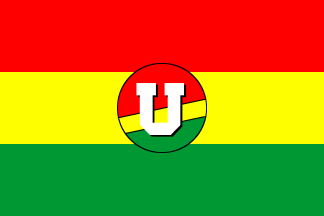 image by Eugene Ipavec, 30 January 2012
image by Eugene Ipavec, 30 January 2012
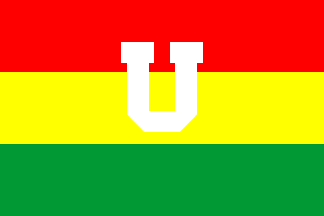 image by Eugene Ipavec, 30 January 2012
image by Eugene Ipavec, 30 January 2012
Social Party of National Unity (Spanish: Partido Social de Unidad Nacional),
or Party of the U (Spanish: Partido de U) is a liberal conservative political
party (center-right) established in 2005. On June 20, 2010, Colombia elected for
the first time in their history a member of the Party of the U to the Presidency
of Colombia, that being Juan Manuel Santos (current President).
Source:
http://en.wikipedia.org/wiki/Social_Party_of_National_Unity
The Party's flag is a red (top), yellow (middle), green (bottom) horizontal flag
with the
logo in the middle.
Screenshot taken on January 27, 2012 of tv
slot granted to all political parties before the 7 p.m. news on public
television broadcast) This flag can also be found
here.
Source:
http://www.elliberal.com.co/liberal/politica/105136-partido-de-la-u-pide-al-gobierno-que-retire-reforma-a-la-educacion
A variant can also be seen
here.
(Source:
http://www.eltiempo.com/noticias/partido-de-la-u )
For additional information go to: Partido
de la U (official website)
Esteban Rivera, 28 January 2012
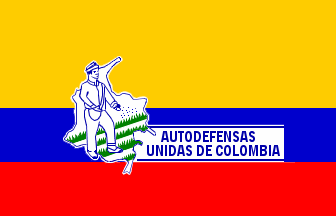 image by Eugene Ipavec, 17 July 2005
image by Eugene Ipavec, 17 July 2005
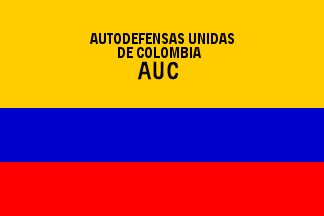 image by Eugene Ipavec, 17 July 2005
image by Eugene Ipavec, 17 July 2005
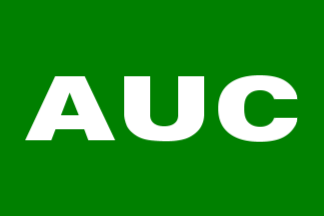 image by Eugene Ipavec, 17 July 2005
image by Eugene Ipavec, 17 July 2005
Name: United Self-Defense Forces of Colombia (AUC).
Mothertongue Name: Las Autodefensas Unidas de Colombia (AUC).
Aliases: United Self-Defense Group of Colombia.
Base of Operation: Colombia.
Founding Philosophy: The United Self-Defense Forces of Colombia
(AUC) was formed to combat the leftist terrorist organizations
operating in Colombia, primarily the FARC and ELN. The AUC grew
out of the paramilitary and self-defense groups formed in the
1980s. These groups were dedicated to protecting the economic
interests of wealthy citizens that were often threatened by
groups such as the FARC. The AUC is a nationalist group that
protects the Colombian government from the Communist-inspired
guerilla movements that threaten it. At first, the various
paramilitary groups enjoyed the tacit approval of the Colombian
military. The paramilitaries and the Colombian military
cooperated in the fight against leftist guerillas. Eventually,
however, the close financial connections between the drug cartels
and the paramilitaries forced the Colombian military to
officially sever ties with the paramilitaries in 1989. Despite
this, the military and the AUC have been accused of continuing
their collaboration unofficially, and many AUC members are former
members of the Colombian military.
The AUC is an umbrella organization comprised of independently
operated paramilitary groups. One of these paramilitaries, the
Peasant Self-Defense Group of Córdoba and Urabá (ACCU), is
thought to have spearheaded the formation of the AUC.
Furthermore, Carlos Castaño Gil, the co-founder and leader of
the ACCU, is recognized as the on-again/off-again AUC leader.
Current Goals: The AUC serves the interests of Colombian economic
elites, drug traffickers, and any local communities that do not
support the leftist rebels. According to the AUC, its primary
objective is to protect its supporters from leftist guerillas.
Clearly, however, the AUC is also keenly interested in
controlling the drug trade, which is its primary source of
earnings. AUC leader Carlos Castaño claims that 70 percent of
the AUC's operational costs are funded by drug-related sources.
The AUC is currently involved in peace negotiations with the
Colombian government. These talks, begun in July 2004, focus on
the disarmament of AUC blocks and their reintegration into the
Colombian Armed Forces in order to provide security in their
local strongholds. Like in past processes with Pablo Escobar's
group, the AUC is trying to negotiate surrender and disarmament
for a promise of non-extradition to the U.S. Despite AUC pledges
to work with the American and Colombian governments to take
action against cocaine production in the areas in which they
operate, the American government has refused to drop their
demands for extradition of AUC leaders. This has led to divisions
within the group and the slow progress of the talks. Analysts
believe that the decline in popular support for the AUC due to
the disappointing progress of the talks will lead to the
strengthening of the FARC and the ELN in areas once dominated by
the AUC.
Official AUC website:
www.colombialibre.org,
Official AC-BCB website:
www.bloquecentralbolivar.org.
Sources:
www.tkb.org,
en.wikipedia.org.
A photo.
E.R., 1 July 2005
Flag 1: First version of the AUC flag (a peasant with a seed
bag sowing a field), with the name of the organization on the
middle of the flag of Colombia). This flag has been actually
flown on many events during the recent peace process between this
organization and the Colombian government.
Flag 2: Second version of the AUC flag (name of the organization
in black lettering on the top of the flag of Colombia). This flag
has been seen on aired TV interviews of top AUC leaders and also
on recent events during the recent peace process between this
organization and the Colombian government.
Flag 3: Third version of the AUC flag (initials of the
organization in white on green background). Attributed flag (I
first saw this image on
www.worldstatesmen.org
a few years ago and I have also seen this image on Colombian
media coverage of the peace process: however I have not seen this
flag displayed).
For current news on the peace process between the AUC and the
Colombian government please reffer to "Alto Comisionado para
la paz" (High Commissioner fo Peace), official website:
www.altocomisionadoparalapaz.gov.co.
The official website of the AUC is 'Colombia Libre' as the armed
movement called 'Los Pepes'. It is
believed that the AUC "core" emerged from 'Los Pepes',
as the flag of 'Los Pepes' bears the motto "Colombia
Libre" (Free Colombia), which is the AUC's website's name.
E.R., 18 July 2005
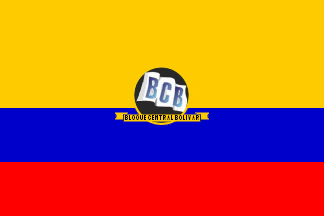 image by Eugene Ipavec, 12 July 2005
image by Eugene Ipavec, 12 July 2005
 image by Eugene Ipavec, 21 February 2006
image by Eugene Ipavec, 21 February 2006
variant
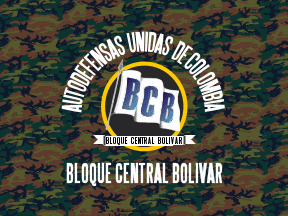 image by Eugene Ipavec, 21 February 2006
image by Eugene Ipavec, 21 February 2006
"black variant"
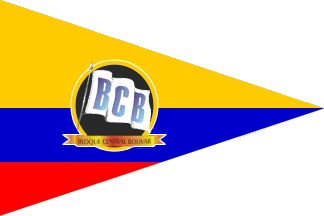 image by Eugene Ipavec and André Coutanche, 1
August 2005
image by Eugene Ipavec and André Coutanche, 1
August 2005
"pennant"
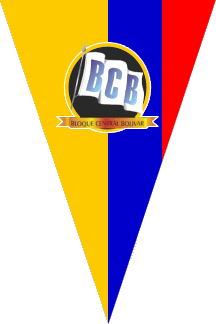 image by Eugene Ipavec and André Coutanche, 26
December 2005
image by Eugene Ipavec and André Coutanche, 26
December 2005
"vertical pennant"
.jpg) image contributed by E.R., 1 July 2005
image contributed by E.R., 1 July 2005
Emblem
The ACBCB (Autodefensas Campesinas - Bloque Central Bolívar,
or Peasant Self Defense - Bolivar Central Bloc) is one of the
main factions of the AUC umbrella organization. It is more
commonly referred to as Bloque Central Bolívar (Bolivar Central
Bloc, because it was established originally on the Department of
Bolívar but it has expanded tremendously to other remote areas
of the country).
E.R., 1 July 2005
The "pennant" is based on photo taken during a
ceremony of laying down of weapons bu the Bloque Libertadores del
Sur, a "sub-bloc" of the much bigger ACBCB and is at
www.altocomisionadoparalapaz.gov.co.
The "vertical pennant is based on photo taken at the
demobilization ceremony of another structure of this paramilitary
force, on December 12, 2005 in the Municipality of Remedios,
Department of Antioquia as shown at
www.altocomisionadoparalapaz.gov.co.
E.R., 1 August and 26 December 2005
The variant is based on photo at
www.altocomisionadoparalapaz.gov.co.
This is another demobilization ceremony for this AUC faction.
This is the second part of the demobilization process. It was
held at the Municipality of Santa Rosa del Sur, in th Department
of Bolívar.
E.R., 5 February 2006
The "black variant" has a camouflage background, the
BCB emblem on the center. On the top it reads AUTODEFENSAS UNIDAS
DE COLOMBIA (in white) and on the bottom, beneath the emblem it
reads BLOQUE CENTRAL BOLIVAR, also in white.
Source: BCB variant at Demobilization ceremony of one of the
factions of the ACBCB. Picture taken on December 12, 2005 at the
Municipality of Remedios, Department of Antioquia and appear at
www.surimages.com.
E.R., 4 July 2006
 image by Eugene Ipavec, 17 June 2006
image by Eugene Ipavec, 17 June 2006
.gif) image by Eugene Ipavec, 11 June 2006
image by Eugene Ipavec, 11 June 2006
Emblem
the ACC (Autodefensas Campesinas de Casanare, or Peasant
Self-Defense of Casanare) named as such because they were first
established in the eastern plains of Colombia, in the Department
of Casanare. This group at some point was part of the AUC
confederation, but it broke away. When it was part of the AUC it
was called the 'Bloque Oriental' (Eastern Bloc).
In image at the newspaper El Tiempo (The Time,
eltiempo.terra.com.co;)
taken in the late 90's or early 2000, it shows the flags
proportion and also from top to bottom, the symbols displayed:
'ACC' lettering in black, a centaur waving a flag (or at least
that's what it seems to me), a shadow of the centaur, and the
words 'Bloque Oriental'. Another image has a description as the
above, only to mention the colors of the flag, which are red
(top), white (center) and green (bottom). The meaning of the
colors is unknown to me. Official website at
www.llanoadentro.com.
E.R., 20 July 2005 and 9 April 2006
 image by Eugene Ipavec, 21 February 2006
image by Eugene Ipavec, 21 February 2006
Image is based on pictures taken during the demobilization
ceremony of the Autodefensas Campesinas del Magdalena Medio
(ACMM) or Peasant Self-Defense of Middle Magdalena. They are
called like that because they are located mainly along the stream
of the Magdalena River, operating basically on the borders of the
Departments of Antioqiua, Boyacá and Santander. The ACMM
comprises six fractions (fronts) and the flag shown is the flag
of the founding front, the Frente José Luis Zuluaga (José Luis
Zuluaga Front). The ACMM belong to the AUC, the confederation of
paramilitary groups in Colombia. The flag is on black background
charged with the Coat of Arms.
Sources:
Alto
Comisionado para la Paz website,
CM& TV news of February
7th, 2006.
E.R., 21 February 2006
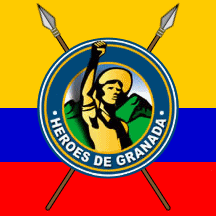 image by Eugene Ipavec, 2 August 2005
image by Eugene Ipavec, 2 August 2005
It is the flag of yet another AUC faction, called "Bloque
Héroes de Granada" (Heroes of Granada Bloc). It is named
after the Municipality of Granada, in the Department of
Antioquia. This group will lay down its weapons either tomorrow
or the day after, during another demobilization act under the
peace process between the AUC and the Colombian government. The
flag is the symbol over the Colombian flag. However the flag that
"should" come out has a proportion of 1:1 so it's more
of a banner (a square with the Colombian tricolour plus the
group's emblem on it in the middle). The faction's official
website is:
www.heroesdegranada.org.
I saw this flag this past week during the troop concentration
prior to their disposal of arms on August. The flag has a peasant
raising his right arm (as the AUC is a far right armed movement)
and two crossed spears.
E.R., 1 August 2005
This group surrendered its weapons and all its rural and urban
structure, with a total of 2033 armed and unarmed
"personnel".
E.R., 2 August 2005
 image by Eugene Ipavec, 5 July 2006
image by Eugene Ipavec, 5 July 2006
This is a paramilitary organization called Bloque Tolima
(Tolima Bloc), for being located on the Department
of Tolima. It belonged to the ACCU (Autodefensas Campesinas
de Córdoba y Urabá), which at the same time belonged to the
much larger AUC (Autodefensas Unidas de Colombia). The Bloque
Tolima group laid down its weapons on October 22, 2005, and
during this ceremony a flag of the group can be seen. I assume
that the flag has the map of Colombia on the left, located
horizontally in the middle, and then the words
"TOLIMA".
Source: official website of the Alto Comisionado Para la
Paz
www.altocomisionadoparalapaz.gov.co.
E.R., 23 December 2005
 image by Eugene Ipavec, 24 July 2007
image by Eugene Ipavec, 24 July 2007
Flag with the old Coat of Arms
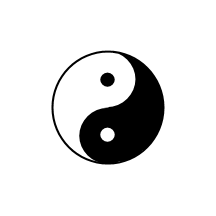 image by Eugene Ipavec, 24 July 2007
image by Eugene Ipavec, 24 July 2007
Flag with the new Coat of Arms
This is yet another faction of the AUC. It is called Bloque
Vencedores de Arauca (Arauca Victors Bloc) because it operates in
the Department of Arauca. It is a
"subbloc" of the
ACBCB.
It had two Coat of Arms: the old one and the new one. This group
had the Coat of Arms on a white square background, and the flag
design is very similar to the
Héroes of Granada Bloc, which a plain square background (this time white
background only) charged with the Coat of Arms.
In the first Coat of Arms used by the group, an oil mill is seen
because the Department of Arauca has plenty of this mineral.
E.R., 24 July 2007
.gif) image by Eugene Ipavec, 3 November 2007
image by Eugene Ipavec, 3 November 2007
logo
There is a movement called Jóvenes Fajardistas (Young
Fajardists), inspired by the Mayor of the City of Medellin Sergio Fajardo Valderrama, who
was in office from 2003 to 2007. This movement bears in its logo
the outlines of several people, which at the same time are party
members. These people are 21 youngsters between the ages of 18
and 32 who are aspiring to the City of Medellin's Council.
Source: Screenshot of blog
website of Júvenes
Fajardistas,
Official
website.
E.R., 3 November 2007
1) I saw two flags on
the online edition of the Colombian newspaper
El
Espectador (The Spectator), dated Sunday, September 18, 2005.
They are related to an article regarding the crisis in Colombian
Labor Unions.
E.R., 19 September 2005
2) I found an article showing two unidentified flags used by
Colombian paramilitary forces (no specific faction though). The
article dates back to August 30, 2006 published by the newspaper
El Colombiano.
The first photo shows a sitting combatant holding a plain white flag with an
udientified logo on it, in what seems to be a demobilization
ceremony of one of the paramilitary structures that composed the
AUC.
The second unknown flag is
a black background rectangular-shaped flag, showing two guns in
plain white. This flag is shown at a protest rally held in an
unknown jail, possibly the High Security jail of Itagüí.
E.R., 1 October 2007